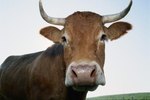
There are two genera of elephants -- African and Asian, distinguished based on genetic and ecological evidence -- but all elephants have similar life cycles and stages of development. African bush elephants live primarily in sub-Saharan savannas while forest elephants live in the rainforests. Asian elephants live in tropical and scrub forests as well as open grasslands throughout India and southeast Asia.
Mating and Gestation
Neither African nor Asian elephants have any set breeding season, although births seem to be more frequent during times of heavy rainfall. Female elephants' estrus cycles last between 13 and 16 weeks, with ovulation lasting about four days. Male elephants, or bulls, seek mates when they've entered musth, a period of intense aggressiveness and sexual drive. Individual males come into musth at a specific time each year, although that season varies between bulls. On average, musth lasts between 6 and 12 weeks. Females give birth to a single calf after a gestation period of 22 months. Elephants give birth to one calf every four to nine years on average.
Infancy
Elephants calves weigh 265 pounds at birth on average. Within about an hour after birth, calves are able to see, smell and walk. They usually begin to suckle within a couple of hours after birth and are wholly dependent on their mothers' milk for the first three months or so of their lives. Infants not only nurse from their own mothers, but also other lactating females in the herd. During their first three months, calves develop their motor skills. At the age of 3 to 4 months, they begin feeding on their own, but continue to nurse for two or three years.
Adolescence
Young elephants remain with their natal herd even after they've been weaned. For the first 10 years of life, both male and female elephants exhibit similar rates of growth and developmental stages. At between 10 and 12 years of age, juvenile elephants' growth rates begin to slow. For juvenile elephants, much of life revolves around play. Young male elephants play chase and spar with other young males, while young female elephants run through the grass chasing birds with other females. African elephants reach sexual maturity between 10 and 12 years old, while Asian elephants become sexually mature slightly later, at around 14 years of age. At this time, males will leave their birth herd, although females remain in the same herd with their mothers, aunts and sisters for life.
Adulthood
African elephants grow to be the world's largest land mammals, with males reaching heights of up to 12 feet at the shoulders and weighing 5 tons. Females are smaller than males, averaging 9 feet tall at the shoulders. Asian elephants tend to be slightly smaller than African elephants, with smaller ears. Unlike their African counterparts, female Asian elephants don't grow tusks. Elephants may live to be 70 years of age and continue to grow throughout their lives. Their growth rate slows as they get older, although there is evidence males have a second growth spurt when they are around 20 years old.
References
Photo Credits
-
Jupiterimages/Photos.com/Getty Images
Writer Bio
Jennifer Mueller began writing and editing professionally in 1995, when she became sports editor of her university's newspaper while also writing a bi-monthly general interest column for an independent tourist publication. Mueller holds a Bachelor of Arts in political science from the University of North Carolina at Asheville and a Juris Doctor from Indiana University Maurer School of Law.




